Taxonomy
Family: Siricidae
Subfamily: Siricinae
Genus: Sirex Linnaeus, 1760
Species: Sirex longicauda Middlekauff, 1948
Common names: none
Background
Sirex longicauda is a western NearcticNearctic:
describing the region of the Northern Hemisphere that includes North America south through northern Mexico
 species with black body, red legs, and a very long, distinctive ovipositorovipositor:
species with black body, red legs, and a very long, distinctive ovipositorovipositor:
the female organ that deposits eggs and is used to drill into plant tissue, located at the apex of the abdomen, made up of the lance and lancet
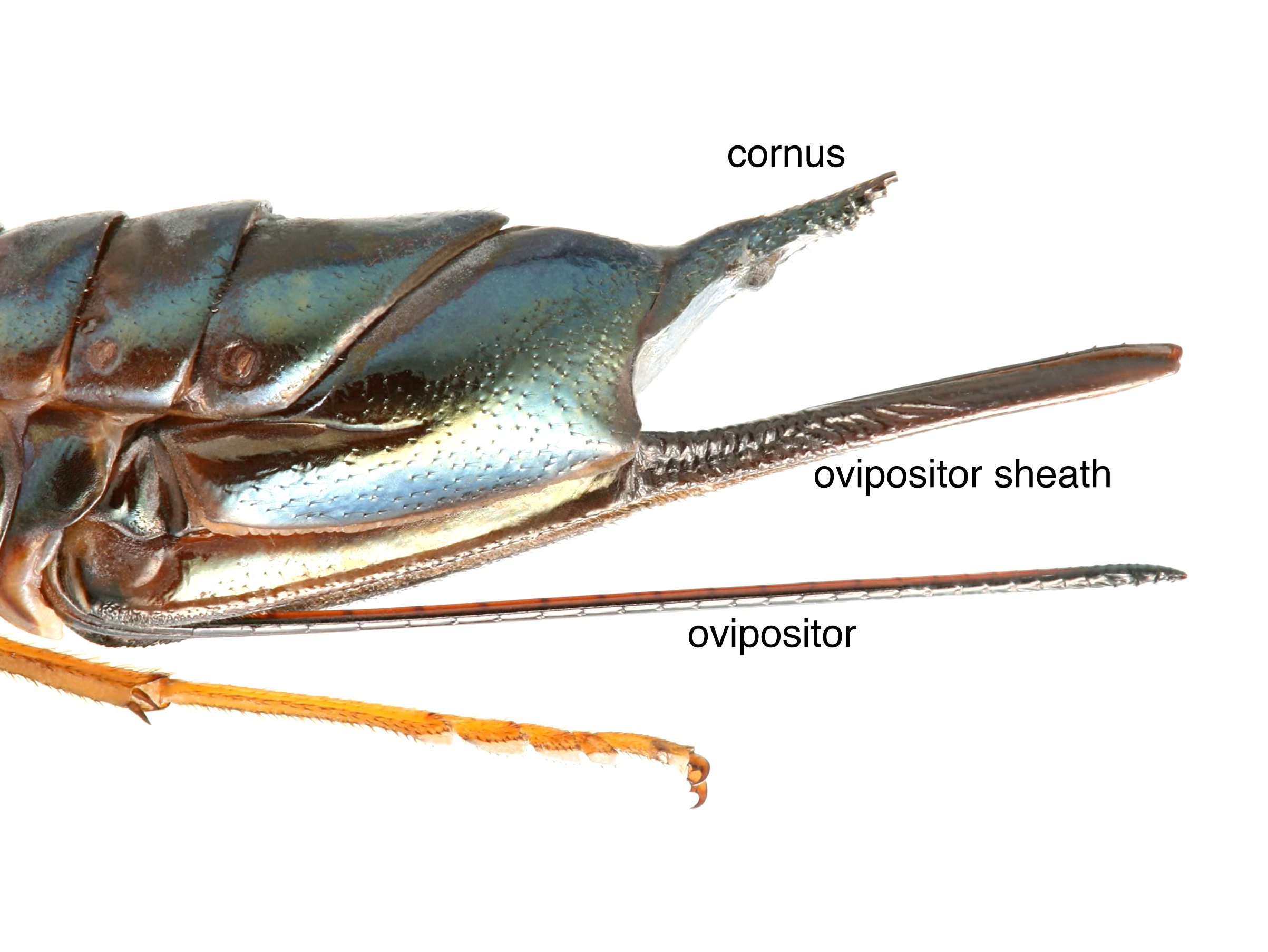 (Schiff et al. 2012Schiff et al. 2012:
(Schiff et al. 2012Schiff et al. 2012:
Schiff NM, Goulet H, Smith DR, Boudreault C, Wilson AD, and Scheffler BE. 2012. Siricidae (Hymenoptera: Symphyta: Siricoidea) of the Western Hemisphere. Canadian Journal of Arthropod Identification 21: 1-305.).
Diagnostic characteristics
See Sirex for genus-level diagnostic characteristics.
Females:
- hind femurfemur:
the third segment of the leg between the trochanter and the tibia
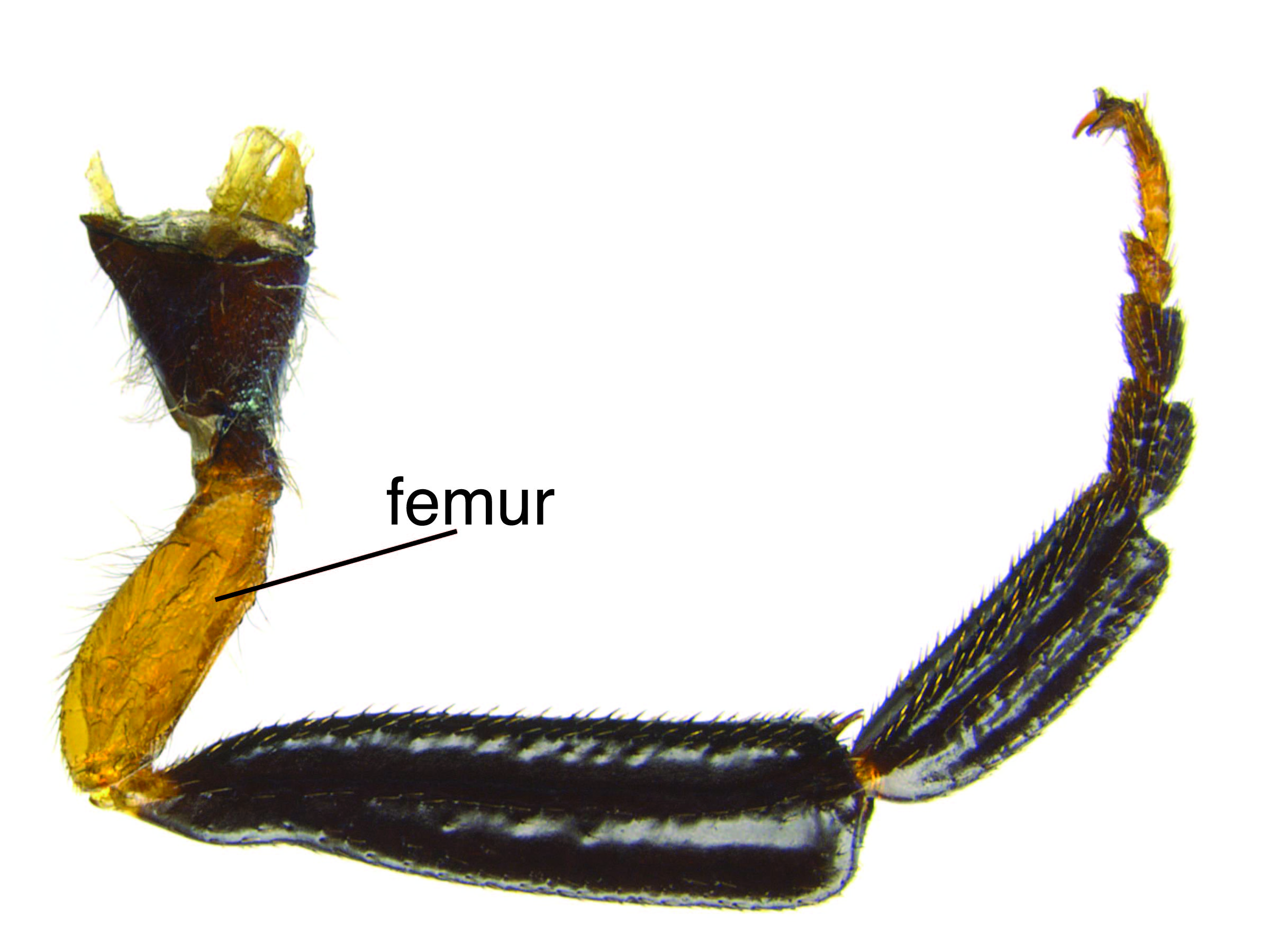 black (Schiff et al. 2012Schiff et al. 2012:
black (Schiff et al. 2012Schiff et al. 2012:
Schiff NM, Goulet H, Smith DR, Boudreault C, Wilson AD, and Scheffler BE. 2012. Siricidae (Hymenoptera: Symphyta: Siricoidea) of the Western Hemisphere. Canadian Journal of Arthropod Identification 21: 1-305.)
- abdomen abdomen:
the third and last segment of an insect's body; in sawflies this is usually made up of 11 segments (segments 9 and 10 often fused)
 entirely black with metallic reflections (Schiff et al. 2012Schiff et al. 2012:
entirely black with metallic reflections (Schiff et al. 2012Schiff et al. 2012:
Schiff NM, Goulet H, Smith DR, Boudreault C, Wilson AD, and Scheffler BE. 2012. Siricidae (Hymenoptera: Symphyta: Siricoidea) of the Western Hemisphere. Canadian Journal of Arthropod Identification 21: 1-305.)
- tibia tibia:
the fourth segment of the leg, between the femur and the tarsus
 and tarsustarsus:
and tarsustarsus:
the fifth and last segment of the leg
 reddish-brown (Schiff et al. 2012Schiff et al. 2012:
reddish-brown (Schiff et al. 2012Schiff et al. 2012:
Schiff NM, Goulet H, Smith DR, Boudreault C, Wilson AD, and Scheffler BE. 2012. Siricidae (Hymenoptera: Symphyta: Siricoidea) of the Western Hemisphere. Canadian Journal of Arthropod Identification 21: 1-305.)
- fore wing fore wing:
the anterior wing of each pair of wings; usually the largest wing of the pair
 hyaline (Schiff et al. 2012Schiff et al. 2012:
hyaline (Schiff et al. 2012Schiff et al. 2012:
Schiff NM, Goulet H, Smith DR, Boudreault C, Wilson AD, and Scheffler BE. 2012. Siricidae (Hymenoptera: Symphyta: Siricoidea) of the Western Hemisphere. Canadian Journal of Arthropod Identification 21: 1-305.)
- fore wing fore wing:
the anterior wing of each pair of wings; usually the largest wing of the pair
 vein 3A present (Schiff et al. 2012Schiff et al. 2012:
vein 3A present (Schiff et al. 2012Schiff et al. 2012:
Schiff NM, Goulet H, Smith DR, Boudreault C, Wilson AD, and Scheffler BE. 2012. Siricidae (Hymenoptera: Symphyta: Siricoidea) of the Western Hemisphere. Canadian Journal of Arthropod Identification 21: 1-305.)
- gena gena:
the area of the head between the compound eye and clypeus; also called the cheek
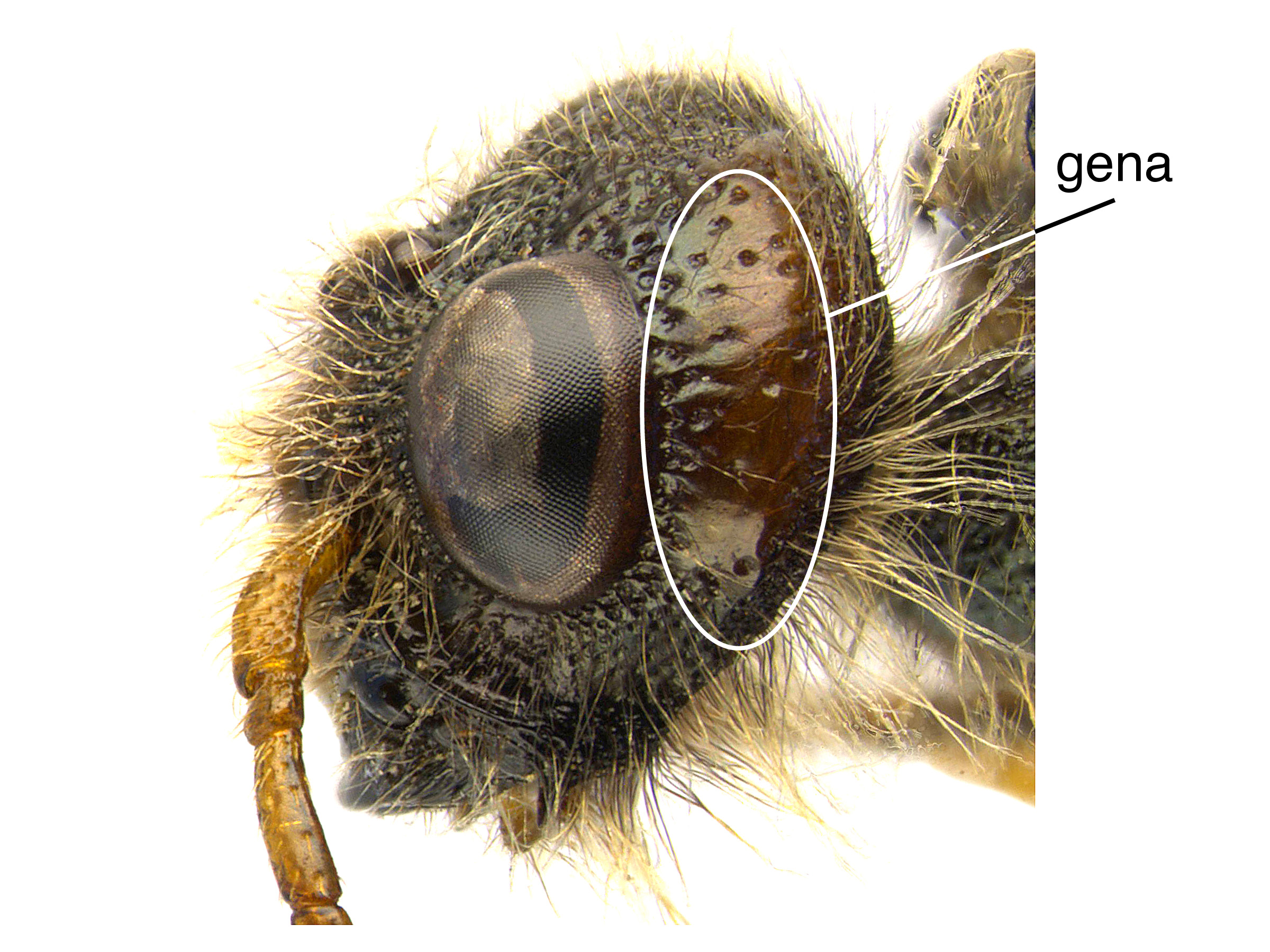 pits scattered, about 2–8 pit diameters apart (Schiff et al. 2012Schiff et al. 2012:
pits scattered, about 2–8 pit diameters apart (Schiff et al. 2012Schiff et al. 2012:
Schiff NM, Goulet H, Smith DR, Boudreault C, Wilson AD, and Scheffler BE. 2012. Siricidae (Hymenoptera: Symphyta: Siricoidea) of the Western Hemisphere. Canadian Journal of Arthropod Identification 21: 1-305.)
- vertex vertex:
the dorsal portion of the head between the compound eyes, between the occiput and frons
pits scattered and small, about 0.16 times diameter of laterallateral:
of or towards the side of the body
ocellus (Schiff et al. 2012Schiff et al. 2012:
Schiff NM, Goulet H, Smith DR, Boudreault C, Wilson AD, and Scheffler BE. 2012. Siricidae (Hymenoptera: Symphyta: Siricoidea) of the Western Hemisphere. Canadian Journal of Arthropod Identification 21: 1-305.)
- second hind tarsomeretarsomere:
a segment of the tarsus
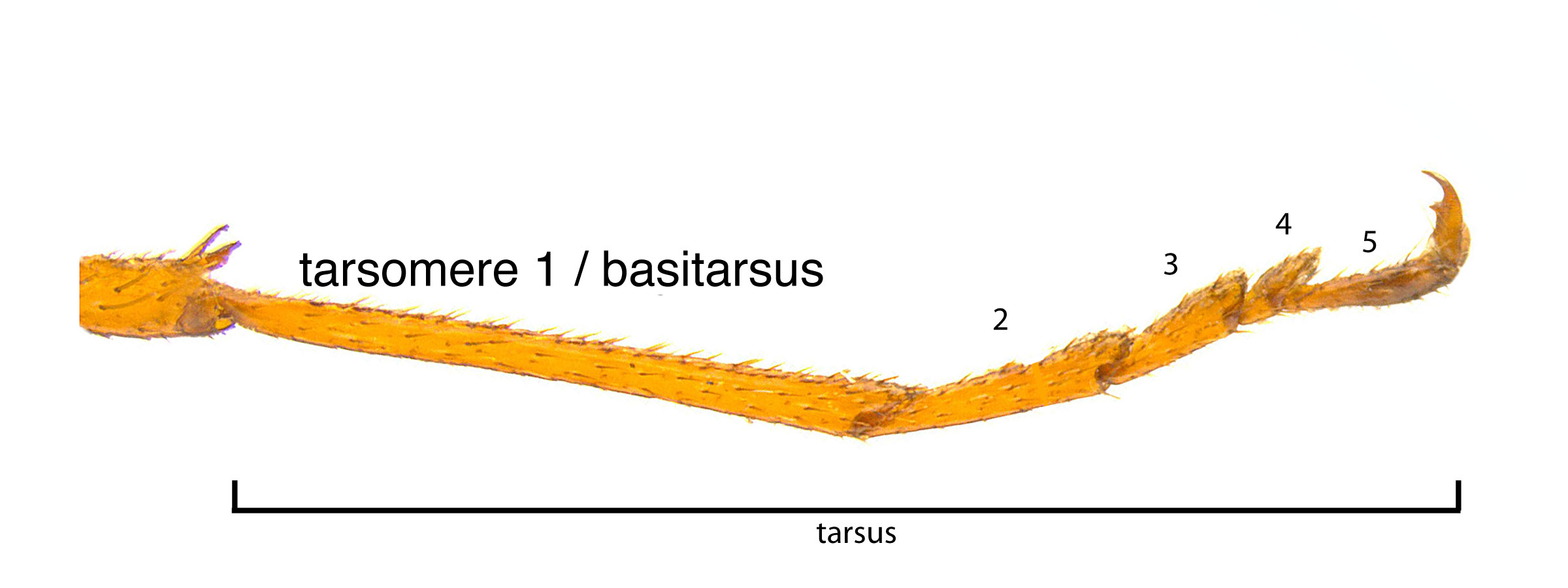 4–5 times as long as wide (Schiff et al. 2012Schiff et al. 2012:
4–5 times as long as wide (Schiff et al. 2012Schiff et al. 2012:
Schiff NM, Goulet H, Smith DR, Boudreault C, Wilson AD, and Scheffler BE. 2012. Siricidae (Hymenoptera: Symphyta: Siricoidea) of the Western Hemisphere. Canadian Journal of Arthropod Identification 21: 1-305.)
- mesoscutum mesoscutum:
the central and dorsal portion of the thorax between the scutellum and postnotum
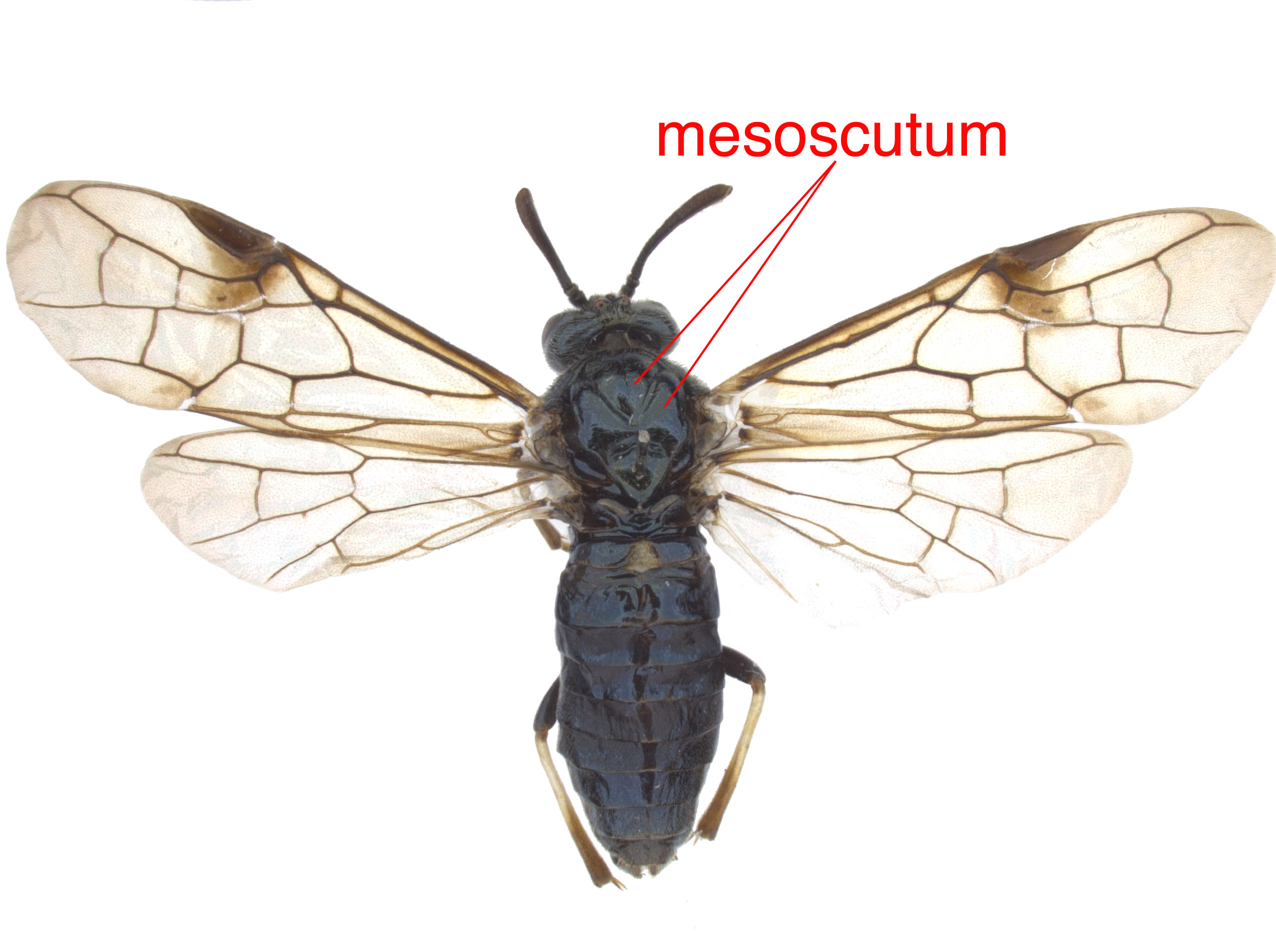 pits dense and round, often in transverse ridges (Schiff et al. 2012Schiff et al. 2012:
pits dense and round, often in transverse ridges (Schiff et al. 2012Schiff et al. 2012:
Schiff NM, Goulet H, Smith DR, Boudreault C, Wilson AD, and Scheffler BE. 2012. Siricidae (Hymenoptera: Symphyta: Siricoidea) of the Western Hemisphere. Canadian Journal of Arthropod Identification 21: 1-305.)
- second hind tarsomeretarsomere:
a segment of the tarsus
 with pulvilluspulvillus:
with pulvilluspulvillus:
soft pads used for surface adhesion, located in sawflies on the first 4 segments of the tarsus
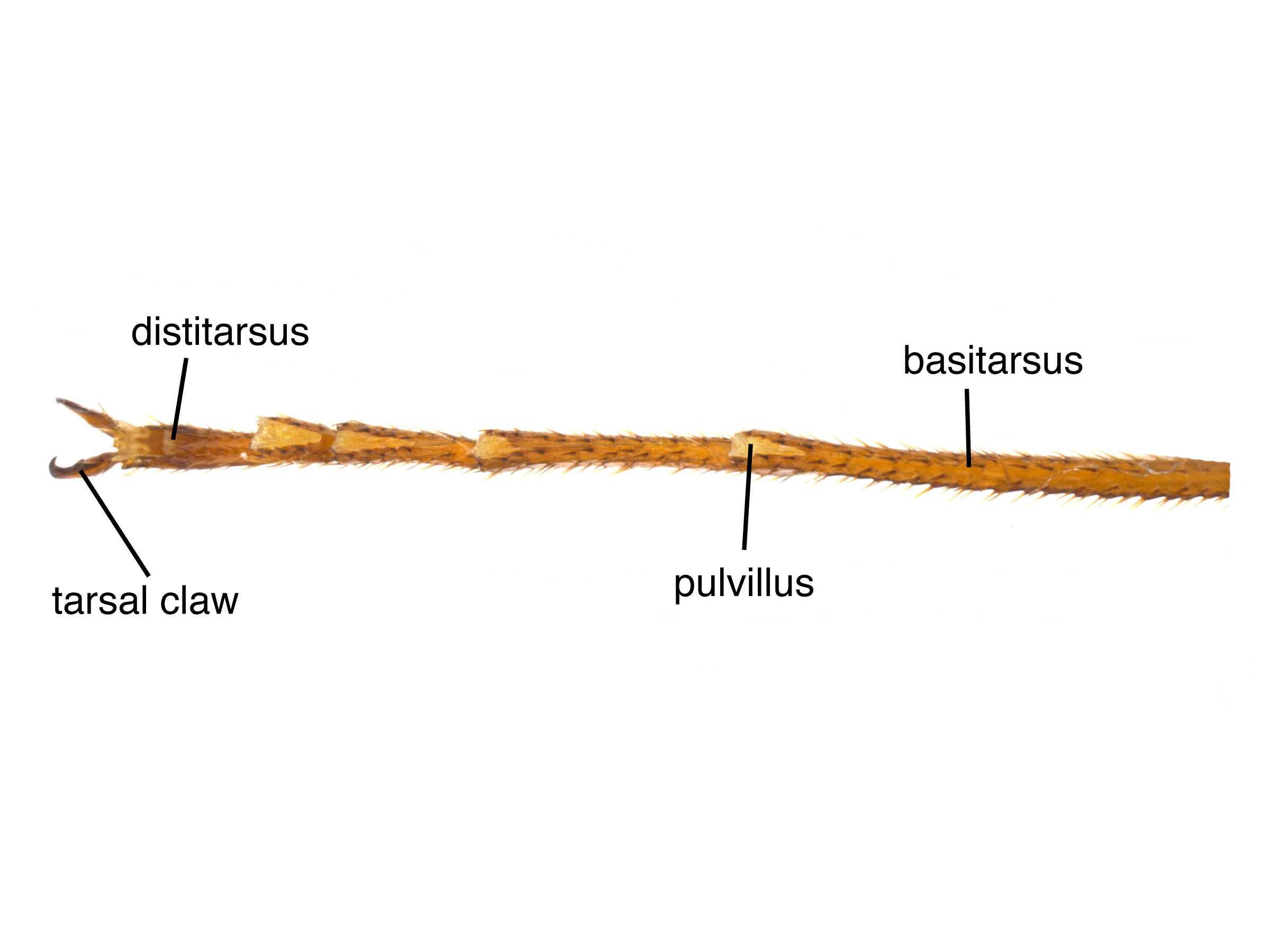 about 0.4 times length of tarsomeretarsomere:
about 0.4 times length of tarsomeretarsomere:
a segment of the tarsus
 (Schiff et al. 2012Schiff et al. 2012:
(Schiff et al. 2012Schiff et al. 2012:
Schiff NM, Goulet H, Smith DR, Boudreault C, Wilson AD, and Scheffler BE. 2012. Siricidae (Hymenoptera: Symphyta: Siricoidea) of the Western Hemisphere. Canadian Journal of Arthropod Identification 21: 1-305.)
- ovipositor ovipositor:
the female organ that deposits eggs and is used to drill into plant tissue, located at the apex of the abdomen, made up of the lance and lancet
 extremely long; ovipositorovipositor:
extremely long; ovipositorovipositor:
the female organ that deposits eggs and is used to drill into plant tissue, located at the apex of the abdomen, made up of the lance and lancet
 length greater than length of the fore wingfore wing:
length greater than length of the fore wingfore wing:
the anterior wing of each pair of wings; usually the largest wing of the pair
 (Schiff et al. 2012Schiff et al. 2012:
(Schiff et al. 2012Schiff et al. 2012:
Schiff NM, Goulet H, Smith DR, Boudreault C, Wilson AD, and Scheffler BE. 2012. Siricidae (Hymenoptera: Symphyta: Siricoidea) of the Western Hemisphere. Canadian Journal of Arthropod Identification 21: 1-305.)
Males:
- hind femurfemur:
the third segment of the leg between the trochanter and the tibia
 black with reddish-brown band at the basebase:
black with reddish-brown band at the basebase:
the beginning or most proximal area of any structure
(Schiff et al. 2012Schiff et al. 2012:
Schiff NM, Goulet H, Smith DR, Boudreault C, Wilson AD, and Scheffler BE. 2012. Siricidae (Hymenoptera: Symphyta: Siricoidea) of the Western Hemisphere. Canadian Journal of Arthropod Identification 21: 1-305.)
- gena gena:
the area of the head between the compound eye and clypeus; also called the cheek
 completely blue-black with metallic reflections (Schiff et al. 2012Schiff et al. 2012:
completely blue-black with metallic reflections (Schiff et al. 2012Schiff et al. 2012:
Schiff NM, Goulet H, Smith DR, Boudreault C, Wilson AD, and Scheffler BE. 2012. Siricidae (Hymenoptera: Symphyta: Siricoidea) of the Western Hemisphere. Canadian Journal of Arthropod Identification 21: 1-305.)
- fore and mid tibiaetibia:
the fourth segment of the leg, between the femur and the tarsus
 and tarsitarsus:
and tarsitarsus:
the fifth and last segment of the leg
 completely reddish-brown (Schiff et al. 2012Schiff et al. 2012:
completely reddish-brown (Schiff et al. 2012Schiff et al. 2012:
Schiff NM, Goulet H, Smith DR, Boudreault C, Wilson AD, and Scheffler BE. 2012. Siricidae (Hymenoptera: Symphyta: Siricoidea) of the Western Hemisphere. Canadian Journal of Arthropod Identification 21: 1-305.)
- last abdominal tergitetergite:
a sclerotized segment of the tergum
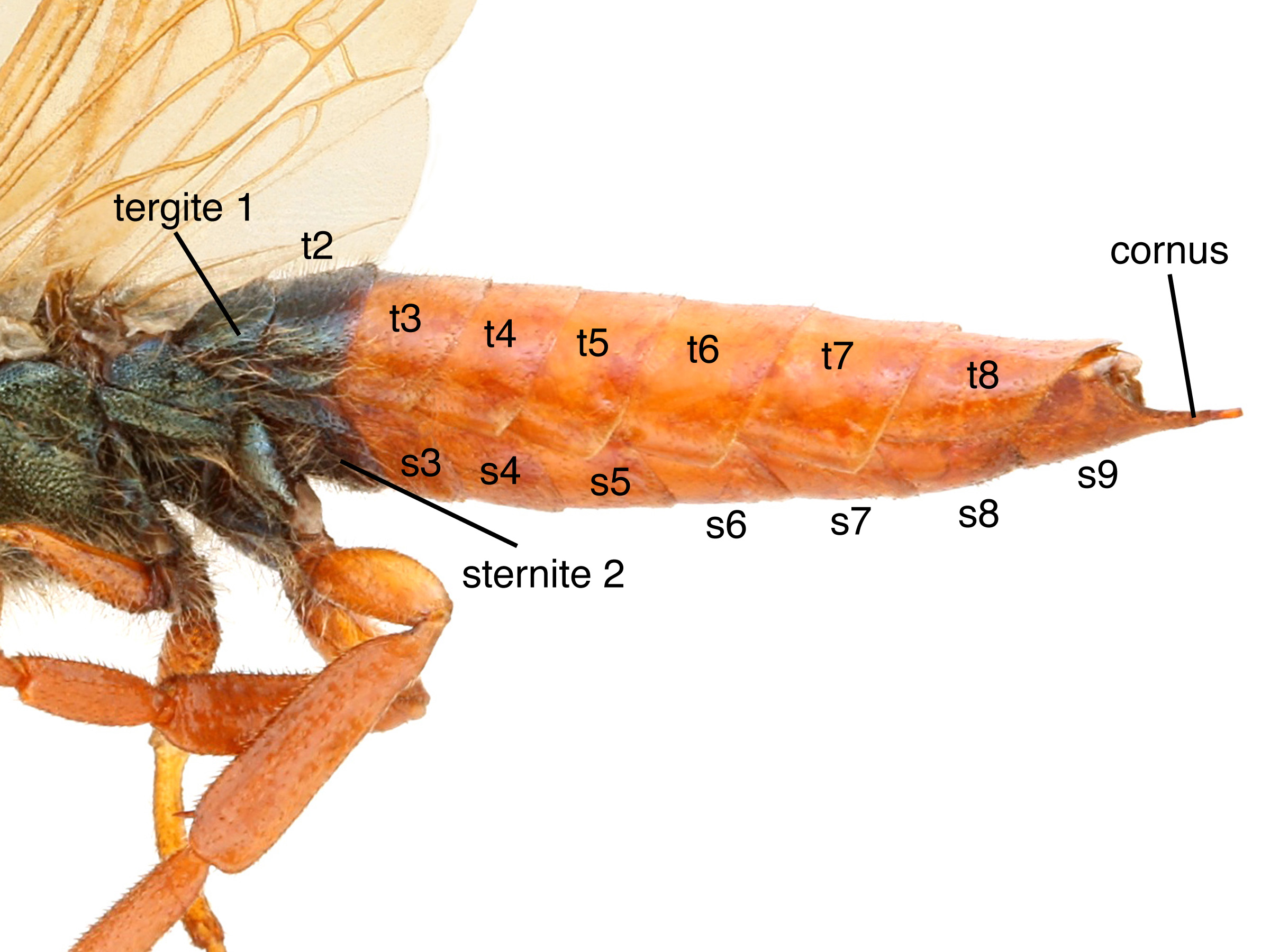 mostly black (Schiff et al. 2012Schiff et al. 2012:
mostly black (Schiff et al. 2012Schiff et al. 2012:
Schiff NM, Goulet H, Smith DR, Boudreault C, Wilson AD, and Scheffler BE. 2012. Siricidae (Hymenoptera: Symphyta: Siricoidea) of the Western Hemisphere. Canadian Journal of Arthropod Identification 21: 1-305.)
- gena gena:
the area of the head between the compound eye and clypeus; also called the cheek
 and vertexvertex:
and vertexvertex:
the dorsal portion of the head between the compound eyes, between the occiput and frons
pits small and scattered (Schiff et al. 2012Schiff et al. 2012:
Schiff NM, Goulet H, Smith DR, Boudreault C, Wilson AD, and Scheffler BE. 2012. Siricidae (Hymenoptera: Symphyta: Siricoidea) of the Western Hemisphere. Canadian Journal of Arthropod Identification 21: 1-305.)
- fore wing fore wing:
the anterior wing of each pair of wings; usually the largest wing of the pair
 hyaline (Schiff et al. 2012Schiff et al. 2012:
hyaline (Schiff et al. 2012Schiff et al. 2012:
Schiff NM, Goulet H, Smith DR, Boudreault C, Wilson AD, and Scheffler BE. 2012. Siricidae (Hymenoptera: Symphyta: Siricoidea) of the Western Hemisphere. Canadian Journal of Arthropod Identification 21: 1-305.)
- antenna antenna:
the sensory organ emerging from the front of the head, usually between the compound eyes and above the clypeus; includes the flagellum, scape and pedicel
 black (Schiff et al. 2012Schiff et al. 2012:
black (Schiff et al. 2012Schiff et al. 2012:
Schiff NM, Goulet H, Smith DR, Boudreault C, Wilson AD, and Scheffler BE. 2012. Siricidae (Hymenoptera: Symphyta: Siricoidea) of the Western Hemisphere. Canadian Journal of Arthropod Identification 21: 1-305.)
May be confused with
Sirex longicauda females can be distinguished from most Sirex by the long second hind tarsomeretarsomere:
a segment of the tarsus
 and from S. areolatus by the reddish-brown tibiaetibia:
and from S. areolatus by the reddish-brown tibiaetibia:
the fourth segment of the leg, between the femur and the tarsus
 and tarsitarsus:
and tarsitarsus:
the fifth and last segment of the leg
 . Males are distinguished by the reddish-brown fore legs and small vertexvertex:
. Males are distinguished by the reddish-brown fore legs and small vertexvertex:
the dorsal portion of the head between the compound eyes, between the occiput and frons
pits (Schiff et al. 2012Schiff et al. 2012:
Schiff NM, Goulet H, Smith DR, Boudreault C, Wilson AD, and Scheffler BE. 2012. Siricidae (Hymenoptera: Symphyta: Siricoidea) of the Western Hemisphere. Canadian Journal of Arthropod Identification 21: 1-305.).
Morphological and geographical variation
none recorded
Host associations
Sirex species feed on trees of Pinaceae and Cupressaceae. Sirex longicauda is recorded on Pinaceae species Abies concolor (white fir), Abies magnifica (grand fir), Abies balsamea (balsam fir), Abies sp., Pinus albicaulis (whitebark pine), Pinus ponderosa (ponderosa pine), Pinus strobus (eastern white pine), Pinus sp., and Pseudotsuga menziesii (Douglas fir). The majority of specimens reared (96%) have been on Abies spp. (fir) (Schiff et al. 2012Schiff et al. 2012:
Schiff NM, Goulet H, Smith DR, Boudreault C, Wilson AD, and Scheffler BE. 2012. Siricidae (Hymenoptera: Symphyta: Siricoidea) of the Western Hemisphere. Canadian Journal of Arthropod Identification 21: 1-305.).
Life history
Female Sirex harbor symbiotic basidiomycete fungus in abdominal glands called mycangia. During oviposition, the site is inoculated with the fungus, which begins to decompose the surrounding wood. LarvaeLarva:
the immature stage of holometabolous insects
 feed on the fungus, and in the process bore galleries through the wood (Johnson 1930Johnson 1930:
feed on the fungus, and in the process bore galleries through the wood (Johnson 1930Johnson 1930:
Johnson CW. 1930. On the variation and abundance of Sirex nitidus Harris. Psyche 37 (3): 281-282. https://doi.org/10.1155/1930/62786, Schiff et al. 2012Schiff et al. 2012:
Schiff NM, Goulet H, Smith DR, Boudreault C, Wilson AD, and Scheffler BE. 2012. Siricidae (Hymenoptera: Symphyta: Siricoidea) of the Western Hemisphere. Canadian Journal of Arthropod Identification 21: 1-305.).
Larvae are creamy white and grub-like in appearance with a dark head capsule. As with adults, larvaelarva:
the immature stage of holometabolous insects
 possess a short dorsaldorsal:
possess a short dorsaldorsal:
of or on the top surface of the body or structure
horn on the posterior end of the body. The larvaelarva:
the immature stage of holometabolous insects
 bore galleries into wood, feeding until pupation and subsequent emergence. Throughout this process, the larvaelarva:
bore galleries into wood, feeding until pupation and subsequent emergence. Throughout this process, the larvaelarva:
the immature stage of holometabolous insects
 use their horn to pack the tunnel behind them with sawdust. Emergence holes are perfectly circular. The fungal symbiont is carried in specialized organs in female larvaelarva:
use their horn to pack the tunnel behind them with sawdust. Emergence holes are perfectly circular. The fungal symbiont is carried in specialized organs in female larvaelarva:
the immature stage of holometabolous insects
 that develop into the mycangia after metamorphosis (Schiff et al. 2012Schiff et al. 2012:
that develop into the mycangia after metamorphosis (Schiff et al. 2012Schiff et al. 2012:
Schiff NM, Goulet H, Smith DR, Boudreault C, Wilson AD, and Scheffler BE. 2012. Siricidae (Hymenoptera: Symphyta: Siricoidea) of the Western Hemisphere. Canadian Journal of Arthropod Identification 21: 1-305.).
The flight period of S. longicauda is from early June to mid-October, with a peak in late September (Schiff et al. 2012Schiff et al. 2012:
Schiff NM, Goulet H, Smith DR, Boudreault C, Wilson AD, and Scheffler BE. 2012. Siricidae (Hymenoptera: Symphyta: Siricoidea) of the Western Hemisphere. Canadian Journal of Arthropod Identification 21: 1-305.).
Distribution
World: North America
North America: Sirex longicauda is mainly a western species with many records from British Columbia, Washington, Oregon, Idaho, Utah, Colorado, California, and New Mexico. There are several specimens farther east that are potentially adventive and brought from the west in lumber (Schiff et al. 2012Schiff et al. 2012:
Schiff NM, Goulet H, Smith DR, Boudreault C, Wilson AD, and Scheffler BE. 2012. Siricidae (Hymenoptera: Symphyta: Siricoidea) of the Western Hemisphere. Canadian Journal of Arthropod Identification 21: 1-305.).
Map data from Washington State Department of Agriculture Entomology Collection.
Details about data used for maps can be found here.
Host plant list
View full screen host table here
 species with black body, red legs, and a very long, distinctive ovipositorovipositor:
species with black body, red legs, and a very long, distinctive ovipositorovipositor: (Schiff et al. 2012Schiff et al. 2012:
(Schiff et al. 2012Schiff et al. 2012: black (Schiff et al. 2012Schiff et al. 2012:
black (Schiff et al. 2012Schiff et al. 2012: entirely black with metallic reflections (Schiff et al. 2012Schiff et al. 2012:
entirely black with metallic reflections (Schiff et al. 2012Schiff et al. 2012: and tarsustarsus:
and tarsustarsus: reddish-brown (Schiff et al. 2012Schiff et al. 2012:
reddish-brown (Schiff et al. 2012Schiff et al. 2012: hyaline (Schiff et al. 2012Schiff et al. 2012:
hyaline (Schiff et al. 2012Schiff et al. 2012: vein 3A present (Schiff et al. 2012Schiff et al. 2012:
vein 3A present (Schiff et al. 2012Schiff et al. 2012: pits scattered, about 2–8 pit diameters apart (Schiff et al. 2012Schiff et al. 2012:
pits scattered, about 2–8 pit diameters apart (Schiff et al. 2012Schiff et al. 2012: 4–5 times as long as wide (Schiff et al. 2012Schiff et al. 2012:
4–5 times as long as wide (Schiff et al. 2012Schiff et al. 2012: pits dense and round, often in transverse ridges (Schiff et al. 2012Schiff et al. 2012:
pits dense and round, often in transverse ridges (Schiff et al. 2012Schiff et al. 2012: with pulvilluspulvillus:
with pulvilluspulvillus: about 0.4 times length of tarsomeretarsomere:
about 0.4 times length of tarsomeretarsomere: (Schiff et al. 2012Schiff et al. 2012:
(Schiff et al. 2012Schiff et al. 2012: extremely long; ovipositorovipositor:
extremely long; ovipositorovipositor: length greater than length of the fore wingfore wing:
length greater than length of the fore wingfore wing: (Schiff et al. 2012Schiff et al. 2012:
(Schiff et al. 2012Schiff et al. 2012: black with reddish-brown band at the basebase:
black with reddish-brown band at the basebase: completely blue-black with metallic reflections (Schiff et al. 2012Schiff et al. 2012:
completely blue-black with metallic reflections (Schiff et al. 2012Schiff et al. 2012: and tarsitarsus:
and tarsitarsus: completely reddish-brown (Schiff et al. 2012Schiff et al. 2012:
completely reddish-brown (Schiff et al. 2012Schiff et al. 2012: mostly black (Schiff et al. 2012Schiff et al. 2012:
mostly black (Schiff et al. 2012Schiff et al. 2012: and vertexvertex:
and vertexvertex: hyaline (Schiff et al. 2012Schiff et al. 2012:
hyaline (Schiff et al. 2012Schiff et al. 2012: black (Schiff et al. 2012Schiff et al. 2012:
black (Schiff et al. 2012Schiff et al. 2012: and from S. areolatus by the reddish-brown tibiaetibia:
and from S. areolatus by the reddish-brown tibiaetibia: and tarsitarsus:
and tarsitarsus: . Males are distinguished by the reddish-brown fore legs and small vertexvertex:
. Males are distinguished by the reddish-brown fore legs and small vertexvertex: feed on the fungus, and in the process bore galleries through the wood (Johnson 1930Johnson 1930:
feed on the fungus, and in the process bore galleries through the wood (Johnson 1930Johnson 1930: possess a short dorsaldorsal:
possess a short dorsaldorsal: bore galleries into wood, feeding until pupation and subsequent emergence. Throughout this process, the larvaelarva:
bore galleries into wood, feeding until pupation and subsequent emergence. Throughout this process, the larvaelarva: use their horn to pack the tunnel behind them with sawdust. Emergence holes are perfectly circular. The fungal symbiont is carried in specialized organs in female larvaelarva:
use their horn to pack the tunnel behind them with sawdust. Emergence holes are perfectly circular. The fungal symbiont is carried in specialized organs in female larvaelarva: that develop into the mycangia after metamorphosis (Schiff et al. 2012Schiff et al. 2012:
that develop into the mycangia after metamorphosis (Schiff et al. 2012Schiff et al. 2012: